Що б ви хотіли надіслати своїм клієнтам: стандартний промолист, що містить вигідні пропозиції та корисну інформацію, чи той самий лист, доповнений веселими елементами гейміфікації?
(Джерело: лист від Kärcher)
Якщо ви обрали другий варіант, то потрапили в гарну компанію! Це мудрий вибір, оскільки гейміфікація може не тільки зробити листи цікавішими, а й підвищити конверсію на 400%.
Отримавши настільки обнадійливі інсайти про те, як саме гейміфікація email-маркетингу підвищує ефективність кампаній, перейдемо до розгляду додаткової статистики.
Переваги гейміфікації в email-маркетингу
Гейміфікація пропонує чимало плюсів у різних сферах бізнесу. Ось як вона може трансформувати вашу роботу в галузі email-маркетингу:
- Конверсія:
- ROI та зростання доходів:
- Залученість користувачів і віральність:
- підвищує залученість за допомогою ігрових елементів;
- підвищує віральність листів.
- Відкриваність:
- просте слово «Гра» може збільшити відкриваність на 25%.
Усе це звучить перспективно, але є одна заковика — просте додавання гри в листи не гарантує зростання доходів. Перш ніж зануритися в гейміфікацію в email-маркетингу, необхідно розібратися в ключових принципах і стратегіях, які допоможуть максимально ефективно використовувати її потенціал.
Визначення гейміфікації в email-маркетингу
Гейміфікація не має на увазі «гру» як таку, але передбачає застосування типових ігрових компонентів до неігрових дій, щоб стимулювати залученість користувачів до продукту або послуги. Простіше кажучи, гейміфікація email-маркетингу розважає клієнтів, мотивує їх до виконання визначеного завдання і змушує повертатися ще.
Ігрові компоненти — це важливі елементи або аспекти, з яких складається гра, що забезпечують її плавне функціонування та захопливий досвід для гравців.
Ось ключові ігрові компоненти гейміфікації:
- досягнення: очки, бейджі та нагороди, або розблокування контенту, що дає змогу отримати доступ до певних речей тільки після досягнення цілі;
- цілі: окреслені цілі або контрольні точки, до яких прагнуть гравці;
- випробування: бої з босами і змагання, щоб залучити і мотивувати гравців;
- можливості для зростання: гравцям надається можливість підвищувати свій рівень, просуватися вперед, дізнаватися щось нове і розвиватися в межах гри;
- правила: чіткі, структуровані інструкції або етапи, яких дотримуються гравці, щоб пройти гру;
- зворотний зв'язок: інформація для гравців про їхній прогрес і напрями розвитку;
- таблиці лідерів: рейтинги, що демонструють становище гравців у турнірній таблиці та сприяють розвитку атмосфери суперництва;
- ком'юніті: почуття причетності серед гравців, що стимулює взаємодію і налагодження відносин;
- герої або сторітелінг: використання сюжету для залучення гравців, що дають їм змогу відчути себе головними героями захопливої історії;
- таймери зворотного відліку: обмеження за часом, які надають грі гостроти і ритму.
Як ми почали свій шлях у гейміфікації email-маркетингу
Кілька років тому на Litmus Live я слухав доповідь «Making Emails Fun», яку підготували Кріс Васкес, chief product officer в AWeber, і Ніколас Гарньє, який тоді працював у Mailjet, а зараз став head of product and advisor у Primary Venture Partners. Їхня авторитетна робота розпалила нашу допитливість та ентузіазм, спонукаючи до подальшого вивчення гейміфікації листів.
Перші кроки
Ми без роздумів вирішили зануритися в гейміфіковані листи. Наша перша кампанія, лист на великодню тематику, містила А/Б-тест, під час якого половина одержувачів зіграла в гру, щоб виграти знижку, а решта отримали код знижки одразу. У грі учасники збирали цифри, заховані за шоколадними яйцями, і вводили їх суми, щоб розблокувати код знижки.
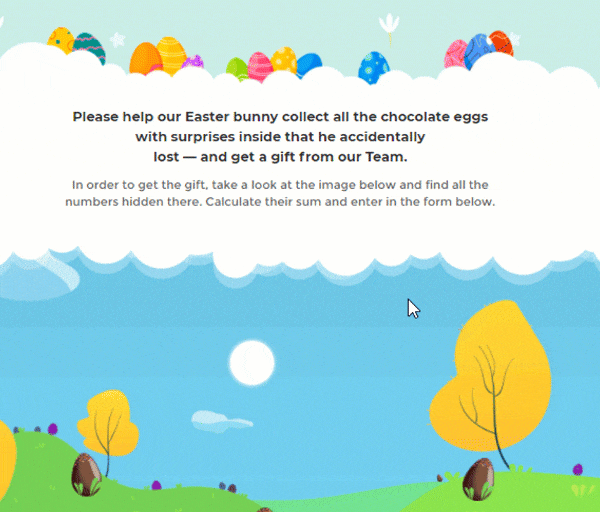
(Переглянути веб-версію цього листа)
На щастя, цей ігровий метод подвоїв продажі порівняно зі звичайними листами зі знижками.
Завдяки гейміфікації продажі зросли на 200%.
Позитивні відгуки одержувачів і подвоєння конверсії спонукали нас додати більше гейміфікованих елементів у майбутні листи. Однак ми усвідомили необхідність вивчення найкращих контекстів і типів листів для ефективної гейміфікації, починаючи з того, що мотивує людей грати. Вивчення цих питань дозволило нам зробити цікаві висновки, якими варто поділитися.
Психологія гейміфікації, або чому гейміфікація в email-маркетингу дає гарні результати
Неможливо змусити людей робити те, що ми хочемо, — їх потрібно мотивувати. У дослідженнях із психології мотивація класифікується як внутрішня або зовнішня. У книзі «Reality is Broken» Джейн Макґоніґал виділяє кілька ключових емоцій, які зачіпає гейміфікація:
- прагнення до досягнень;
- хвилювання та інтрига;
- соціальна взаємодія.
Спираючись на спостереження Макґоніґал і поєднуючи їх із психологічними даними, ми бачимо, що:
- прагнення до досягнень зумовлене як внутрішніми мотивами, як-от особисте задоволення від виконання завдань, так і зовнішніми мотивами, як-от винагорода або визнання;
- азарт та інтрига задіюють нашу внутрішню цікавість і прагнення до новизни, надаючи захопливі сюрпризи, які приваблюють учасників;
- соціальна взаємодія слугує зовнішнім мотиватором, посилюючи зв'язки, конкуренцію і соціальне визнання, тим самим зміцнюючи суспільні відносини та індивідуальність.
Кевін Вербах і Ден Хантер у книжці «For the Win» стверджують, що баланс між внутрішніми та зовнішніми мотиваторами має вирішальне значення для досягнення максимальної ефективності стратегій гейміфікації.
Тепер, коли ми знаємо, чому гейміфікація працює, перейдемо до того, коли слід застосовувати гейміфікацію.
У яких випадках гейміфікація в email-маркетингу доречна
Гейміфікація в листах може значно підвищити залученість клієнтів за різних сценаріїв:
1. Святкові заходи
Здебільшого eCommerce-бізнес зустрічає свята знижками та урочистими привітаннями. Однак постійні розпродажі можуть з часом призвести до втоми покупців і скорочення витрат. Щоб освіжити свій підхід, подумайте про те, щоб вийти за межі традиційних купонів і повідомлень та активно залучати своїх клієнтів.
Для SaaS-компаній, які часто уникають святкових знижок, використання кумедних елементів у листах може бути особливо вигідним. Перехід від стандартних повідомлень «Зі святом!» до більш динамічних розсилок, що запам'ятовуються, може підвищити залученість і залишити незабутнє враження.

(Джерело: Yakaboo)
2. Регулярна взаємодія
Найкращі практики наголошують на необхідності регулярної комунікації, щоб тримати бренд у полі зору. Однак у періоди простою або коли ви просто хочете поліпшити регулярні публікації новин, залучити аудиторію може бути непросто. Гейміфікація листів вирішує цю проблему, пожвавлюючи спілкування; листи з гейміфікацією підтримують залученість клієнтів, інтригують аудиторію і зміцнюють зв'язок між вашим брендом і покупцями.
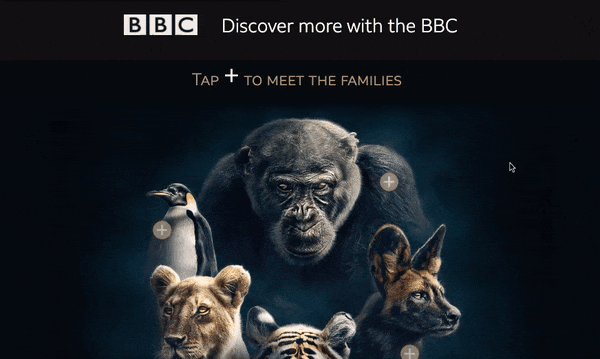
(Джерело: Really Good Emails, BBC)
3. Обмеженість бюджету
Коли великі знижки неможливі, гейміфікація пропонує альтернативу. Наприклад, гра «Колесо Фортуни» в листах може дозволити одержувачам виграти різні знижки, від незначних до солідних, без шкоди для бюджету.
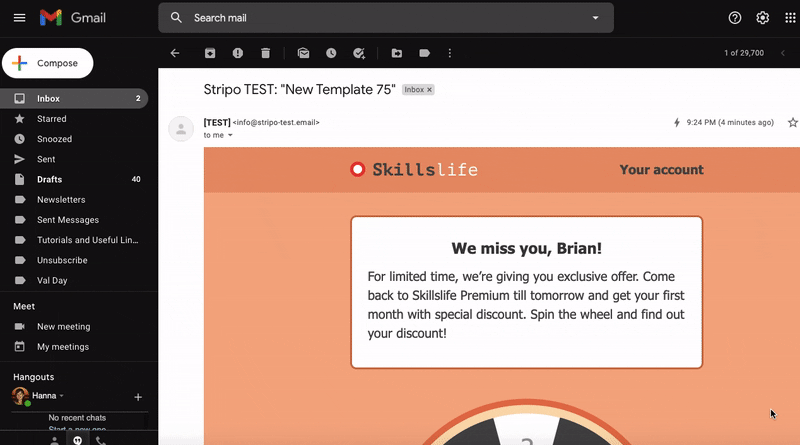
(Джерело: Stripo)
4. Анонси та тизери запуску продуктів
Кампанії з анонсування тизерів і запуску продуктів з елементами гейміфікації можуть підвищити інтерес і очікування нових продуктів. Замість того щоб просто анонсувати продукт, залучіть одержувачів до гри, щоб зробити реліз більш захопливим.
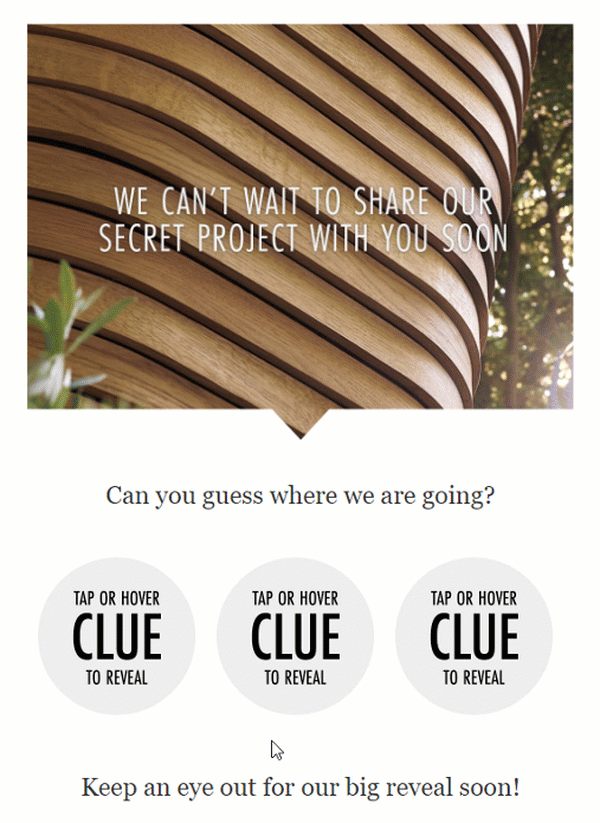
(Джерело: Really Good Emails)
5. Освітній контент
За даними соціального дослідження, учні запам'ятовують до 90% того, що вони дізнаються під час виконання ігрових завдань.
Гейміфікація в email-маркетингу також може трансформувати освітній контент у захопливий процес навчання, що робить його ефективним інструментом для навчання.
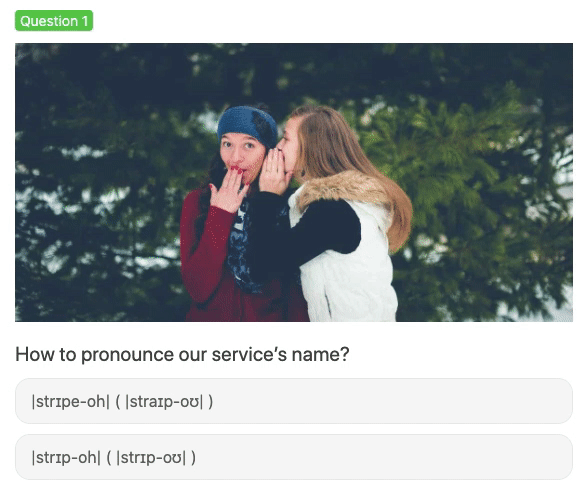
(Джерело: лист від Stripo)
6. Збирання відгуків
Хоча інтерактивні елементи, на зразок збору оцінок NPS у листах, і не є гейміфікацією, їх часто уподібнюють до гейміфікації через захопливий формат. Доведено, що такий підхід дає змогу отримати на 520% більше відповідей користувачів порівняно з традиційними формами, що демонструє ефективність інтерактивних методів збирання відгуків.
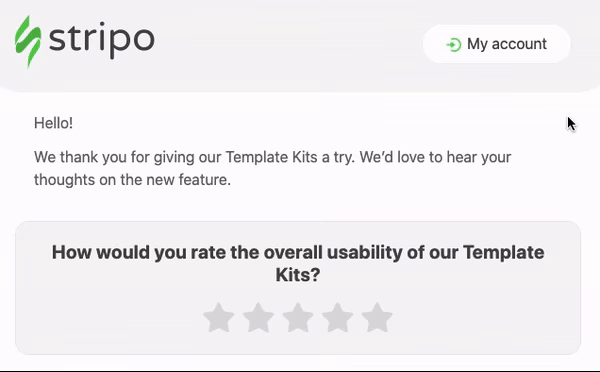
(Джерело: лист від Stripo)
Але на цьому ми не зупинилися. Навпаки, ми подумали про те, що якщо гейміфікація доречна в деяких випадках, то можуть існувати і специфічні гейміфіковані елементи, які підходять для цих ситуацій.
Класифікація ігор в email-маркетингу
Пориньте в розмаїття ігор, які можна використовувати в листах. Від ігор на удачу до творчих конкурсів — подивіться, як кожен тип гри приваблює аудиторію та наповнює кампанії фаном.
1. Азартні ігри
Азартні ігри захоплюють гравців можливістю миттєво виграти щось несподіване, спираючись на непередбачуваність і випадковість для швидкого залучення в гру.
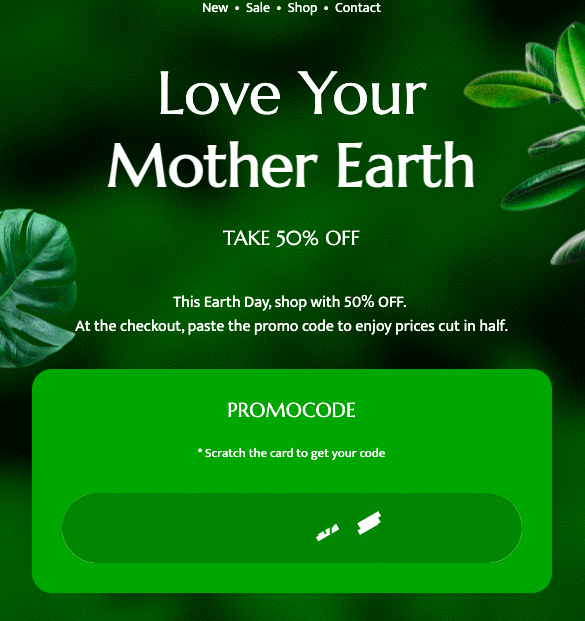
(Джерело: Stripo)
Для яких цілей використовувати азартні ігри: для лідогенерації, збирання даних, залучення клієнтів, зростання продажів і прибутку (за рахунок стимулювання імпульсивних покупок).
2. Освітні ігри
Освітні ігри поєднують навчання з ігровим процесом, залучаючи гравців до інтерактивного отримання знань. Ці ігри приваблюють тих, хто зацікавлений у вдосконаленні навичок або отриманні нової інформації, розважаючись при цьому.
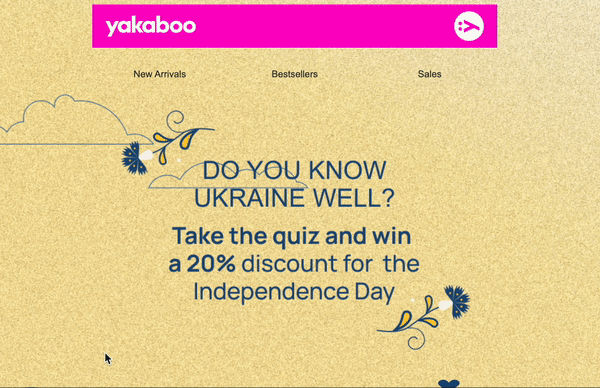
(Джерело: Yakaboo)
Для яких цілей використовувати освітні ігри: для підвищення впізнаваності бренду, залучення клієнтів і просування продуктів.
3. Головоломки
Логічні ігри ставлять перед гравцями завдання, що вимагають уміння долати проблеми і вибудовувати стратегію, і привертають увагу тих, хто любить перевіряти свою логіку і кмітливість, розігруючи складні сценарії і ламаючи голову.
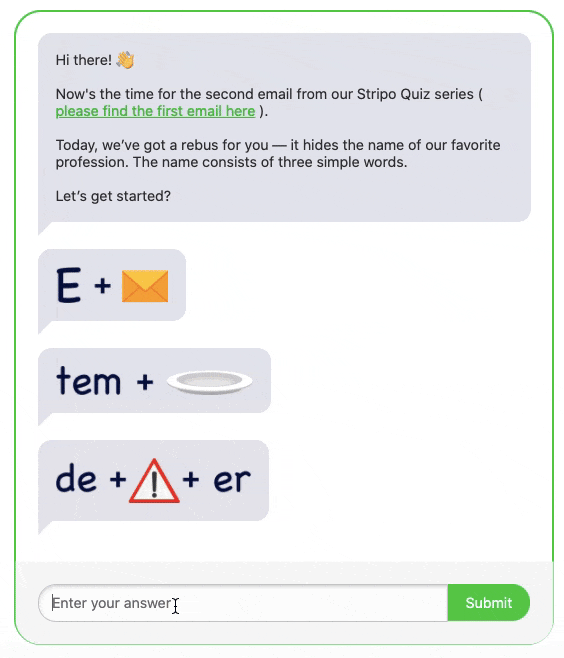
(Джерело: лист від Stripo)
Для яких цілей використовувати ігри-головоломки: для підвищення лояльності клієнтів, їхньої залученості та просування продуктів.
4. Творчі ігри
Креативні ігри задіюють творчий бік гравців, даючи їм змогу створювати або конструювати щось унікальне, взаємодіючи з брендом.
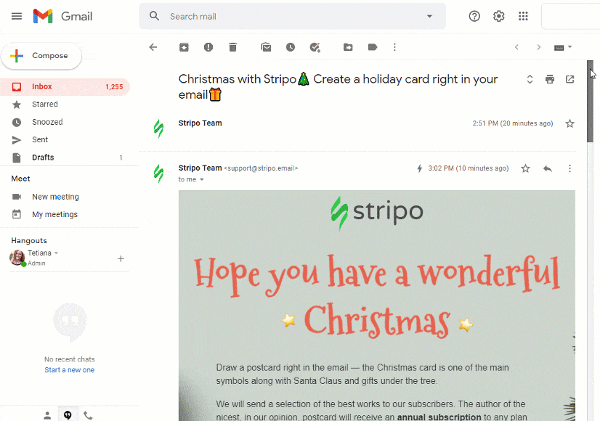
(Джерело: лист від Stripo)
Для яких цілей використовувати творчі ігри: для підвищення впізнаваності бренду (особливо коли email-підписники діляться результатами своїх ігор у соцмережах), залучення клієнтів, утримання клієнтів і підвищення лояльності до бренду.
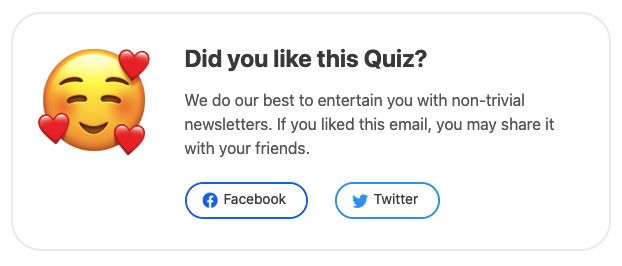
5. Змагальні та конкурсні ігри
Ці ігри стимулюють дух суперництва, пропонуючи різні конкурси та випробування, які ідеально підходять для гравців, охочих до прямої конкуренції та бажаючих перевершити інших або набрати високі бали. Ці ігри також можуть вимагати щоденних або щотижневих коротких взаємодій, що є ідеальним варіантом для підтримання регулярного контакту клієнтів з брендом.
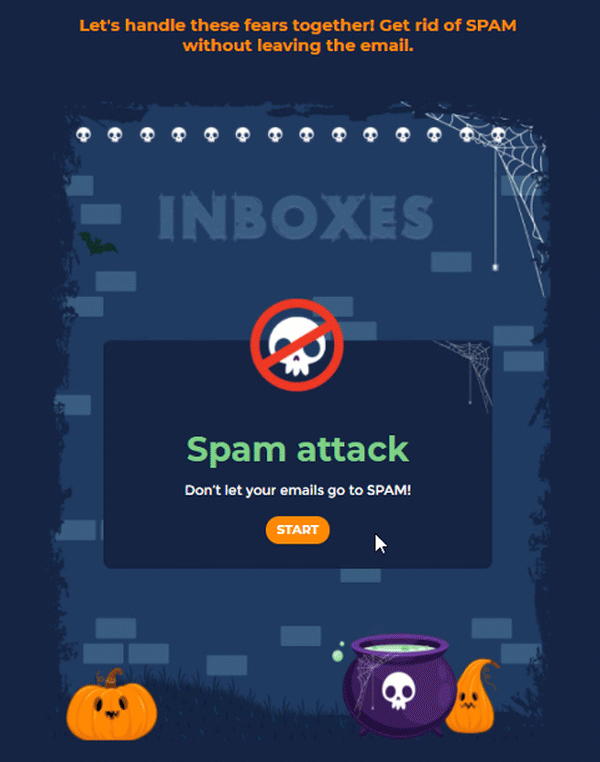
(Джерело: лист від Stripo)
Для яких цілей використовувати змагальні та конкурсні ігри: для залучення користувачів, утримання клієнтів, просування продуктів, зростання продажів і прибутку.
6. Ігри-дослідження
Пізнавальні ігри занурюють гравців у середовище, де дослідження є ключовим моментом, і приваблюють шукачів пригод, спраглих розкрити таємниці, відвідати невідомі території та познайомитися з новими світами.
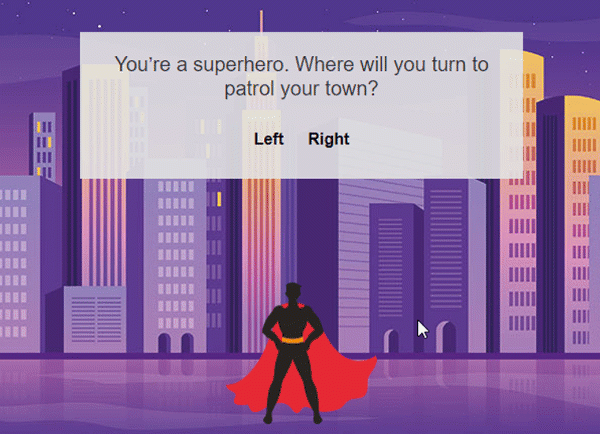
(Джерело: Stripo)
Для яких цілей використовувати ігри-дослідження: для залучення клієнтів, формування лояльності до бренду, підвищення впізнаваності бренду, просування продуктів, зростання продажів і доходів.
У своїй статті «Класифікація ігор і маркетингові цілі, які вони переслідують» ми детально розбираємо кожен тип ігор, розповідаючи про їхні характеристики, маркетингові цілі, тривалість гри і популярні приклади.
З'ясувавши, що мотивує людей грати, і визначивши, коли гейміфікація в email-маркетингу є найдоречнішою і яку гру слід використовувати, ми вирішили, що розібралися в гейміфікації. Однак незабаром з'ясувалося, що нам ще багато чого належить дізнатися; ми лише торкнулися основи.
Що допомогло нам усвідомити це? І до яких висновків це нас привело?
Риси вдалої гейміфікованої email-маркетингової кампанії
Кілька років тому ми запустили розсилку-гру, в якій підписники мали ловити листи зі спамом. На жаль, ми не врахували важливі деталі: правила і таймер. Без візуального індикатора часу гравці не знали, що гра обмежена за часом. Ця помилка змусила нас глибше копнути тему про найважливіші риси успішної гри.
Для розуміння того, що робить гру привабливою для клієнтів і повноцінною, ми ретельно вивчили бестселер Джейн Макґоніґал Reality Is Broken, а також For the Win і The Gamification Toolkit: Dynamics, Mechanics, and Components Кевіна Вербаха та Дена Гантера, і Actionable Gamification: Beyond Points, Badges, and Leaderboards Ю-кай Чоу. Ми також проаналізували власний досвід і досвід своїх клієнтів.
1. Ціль
Мета має бути зрозумілою, помірно захопливою, складною, досяжною і співзвучною з цінностями учасників. Вона може бути спрямована як на внутрішню, так і на зовнішню мотивацію. Повідомляйте про єдину мету, щоб зберегти фокус і не перевантажувати гравців безліччю завдань.
2. Правила
Правила мають важливе значення для того, щоб скеровувати одержувачів до мети та сприяти стратегічному мисленню й різним підходам, що підтримують залученість і справедливість.
3. Зворотний зв'язок (Прогрес)
Зворотний зв'язок у гейміфікованих листах підвищує внутрішню мотивацію, оскільки дає змогу гравцям коригувати свою поведінку залежно від отриманих даних, що посилює загальну залученість і підвищує ефективність стратегії гейміфікації.
4. Персонаж або сюжет
Використовуйте одного персонажа або безперервну сюжетну лінію, щоб зробити ігри більш цілісними. Дозвольте такі взаємодії, як годування або порятунок, які можуть бути пов'язані з розповіддю бренду або бути самостійними.
5. Ком'юніті
Формуйте почуття єдності, порівнюючи досягнення гравців і пропонуючи ділитися ними в соцмережах. Це формує відчуття причетності та може бути підкріплено фразами на кшталт «Ти зробив це краще, ніж 80% усіх одержувачів». Апеляція до зовнішньої мотивації.
6. Дослідження / Елемент випадковості
Додайте елементи випадковості та вибору, наприклад різні результати залежно від рішень гравця, щоб підвищити залученість і підігріти допитливість.
7. Добровільна участь
Визнайте, що не всі підписники можуть захотіти долучатися до гри з різних причин. Надайте їм можливість пропустити цю частину й одразу перейти до іншого контенту або покупок.
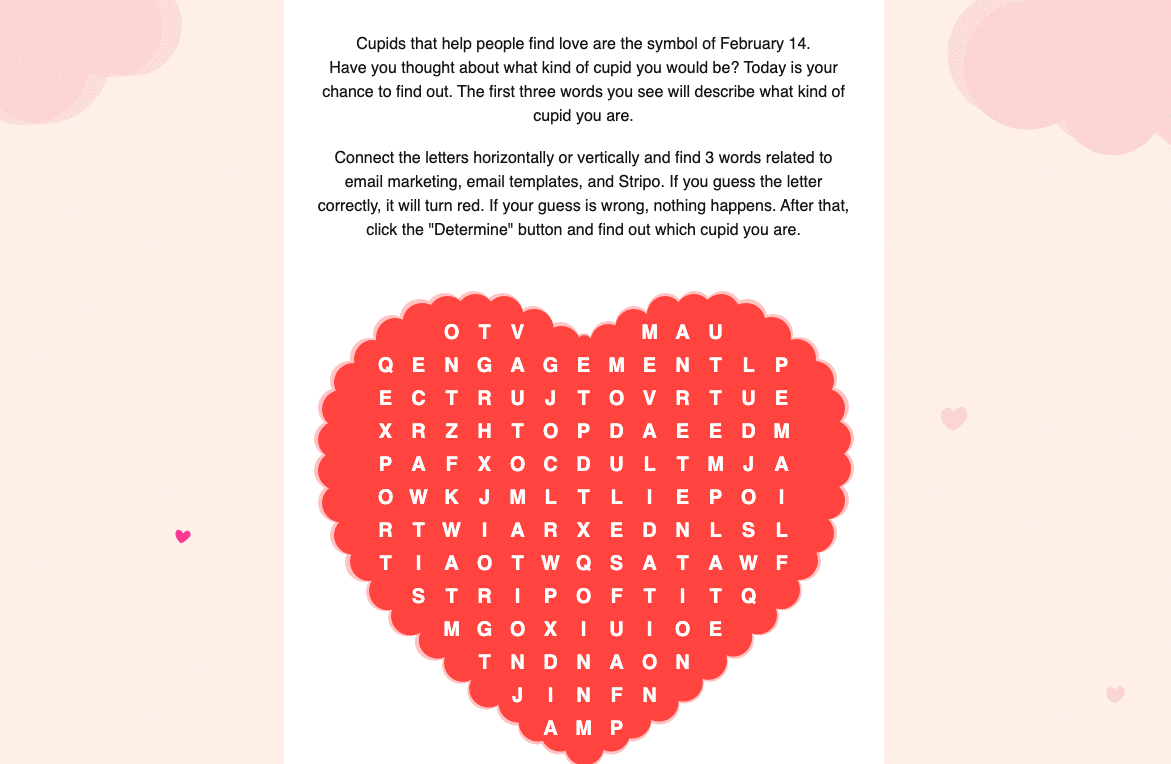
(Джерело: лист від Stripo)
У цьому прикладі зображено всі риси успішної гри:
- мета: перевірте свої навички, знайшовши якомога більше слів і дізнавшись, який ви купідон;
- правила: знайдіть слова, викладені по вертикалі або діагоналі;
- зворотний зв'язок: кожен клік викликає реакцію. Щойно всі три слова буде знайдено, з'явиться кнопка «Визначити»;
- персонаж: кожен гравець є головним героєм гри;
- ком'юніті: знайшовши свого купідона, гравці можуть поділитися отриманими результатами в соцмережах;
- дослідження: гравці стикаються з несподіваними результатами при кожному новому словосполученні, що гарантує нові враження щоразу;
- добровільна участь: основною метою гри є розвага, без грошових винагород або розблокування контенту. Гравці можуть відмовитися від участі, просто закривши лист. Проте, ця гра увійшла до трійки наших найуспішніших ігор, досягнувши показника CTOR удесятеро вищого, ніж у наших звичайних розсилок.
Процес розробки гри
Розробка гри здійснюється таким чином і передбачає кілька найважливіших етапів:
1. Вибір мети гейміфікованої email-кампанії
- визначте маркетингову мету — від неї залежить контент;
- визначтеся з етапом воронки продажів;
- визначте свою цільову аудиторію;
- визначте кінцеву дію, яку мають виконати гравці;
- вирішіть, що отримають гравці;
- визначте, як буде оцінюватися успішність кампанії.
Маркетингові цілі та типи ігор, які їм підходять:
- утримання та лояльність клієнтів: творчі ігри, ігри-головоломки, освітні, змагальні, а також азартні ігри;
- просування продуктів: ігри-дослідження, освітні ігри, ігри-головоломки, змагальні ігри;
- підвищення впізнаваності бренду: освітні ігри, ігри-головоломки та ігри-дослідження;
- зростання продажів і доходів: азартні ігри та ігри-головоломки;
- залучення клієнтів: творчі ігри, ігри-головоломки, освітні, змагальні та конкурсні ігри.
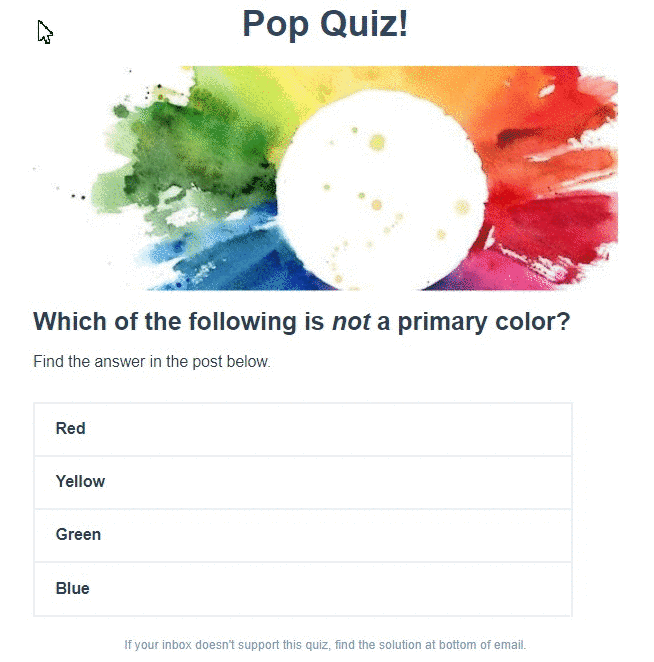
(Джерело: лист від HubSpot)
2. Додавання емоційного аспекту в гру
Крім основних цілей, які мають бути присутніми у всіх іграх і мотивувати підписників до гри, подумайте про застосування універсальних ігрових бустерів із комбінуванням їх різними способами.
Ключові ігрові бустери для підвищення ефективності листів:
- таблиці лідерів: посилюйте конкуренцію за допомогою глобальних або тематичних таблиць лідерів;
- бейджи та нагороди: пропонуйте віртуальні або фізичні нагороди за досягнення;
- персоналізація: кастомізуйте ігрові сценарії та аватари відповідно до індивідуальних уподобань;
- ризик втрати прогресу: підсилюйте ігрові враження, запроваджуючи потенційну втрату прогресу або штрафи, підвищуючи ставки та залученість;
- таймери зворотного відліку: додайте терміновості за допомогою завдань із таймером;
- сторітелінг / герої: створіть емоційний зв'язок за допомогою історій і розвитку персонажів;
- зростання і розвиток: заохочуйте постійну участь за допомогою дерев навичок і систем рівнів;
- мотивована залученість: пов'яжіть ігри з особистими цінностями або цілями.
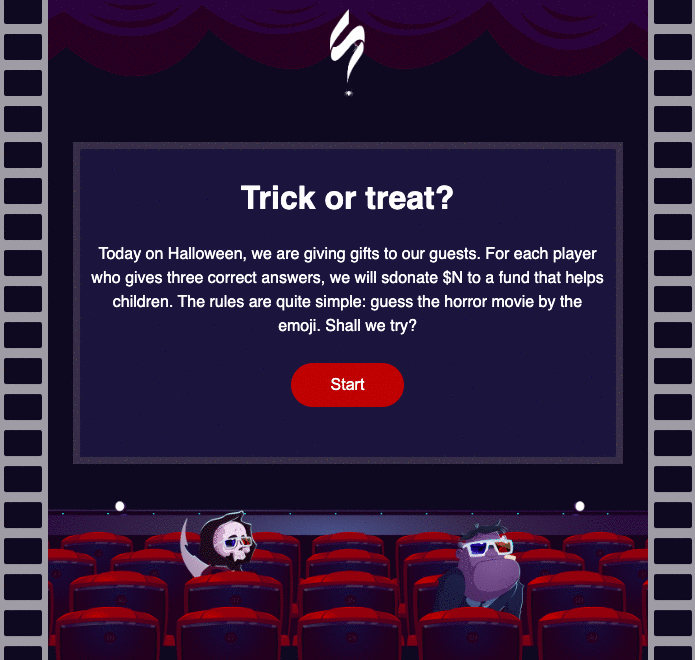
(Джерело: лист від Stripo)
У статті «Ігрові бустери» ми розглянули, як комбінувати бустери, коли і як застосовувати їх для досягнення максимального ефекту, а також навели приклади з практики.
3. Запуск гри
На цьому етапі потрібно розробити дизайн гри, щоб усі одержувачі, незалежно від їхніх поштових клієнтів і вашого ESP, могли повноцінно брати участь у ній. Також потрібно протестувати гру, вжити заходів щодо захисту від зламу (що дуже важливо, якщо пропонуються грошові винагороди) і організувати підтримку після запуску.
Оптимізація цих процесів може значно зекономити час, про що ми розповімо в одній з наступних статей.
У наступному матеріалі ми поговоримо про:
- технічні вимоги до гри та інтерактивності як такої;
- стратегії швидкого створення ігор;
- методи економії часу в процесі розробки;
- підходи до тестування гейміфікованих листів;
- підтримку після запуску.
На завершення
Насамкінець слід зазначити, що інтеграція гейміфікації в email-маркетинг не тільки робить комунікацію приємнішою і захопливішою, а й значно підвищує конверсію і ROI. Використовуючи емоційні та психологічні тригери і застосовуючи гейміфікацію в різних маркетингових сценаріях, компанії можуть створювати динамічний і незабутній досвід в email. Надалі розумне використання елементів гейміфікації, продуманий дизайн ігор і чіткі цілі, як і раніше, відіграватимуть важливу роль у конкурентній боротьбі у сфері email-маркетингу. Стежте за найкращими практиками і постійно впроваджуйте інновації, щоб зберігати залученість і зацікавленість аудиторії.


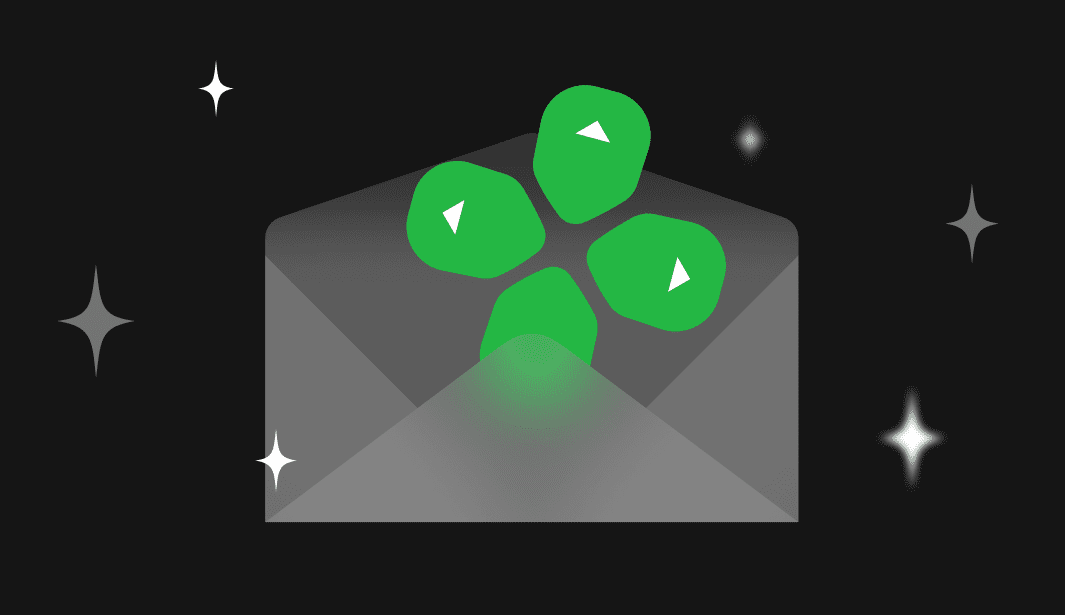
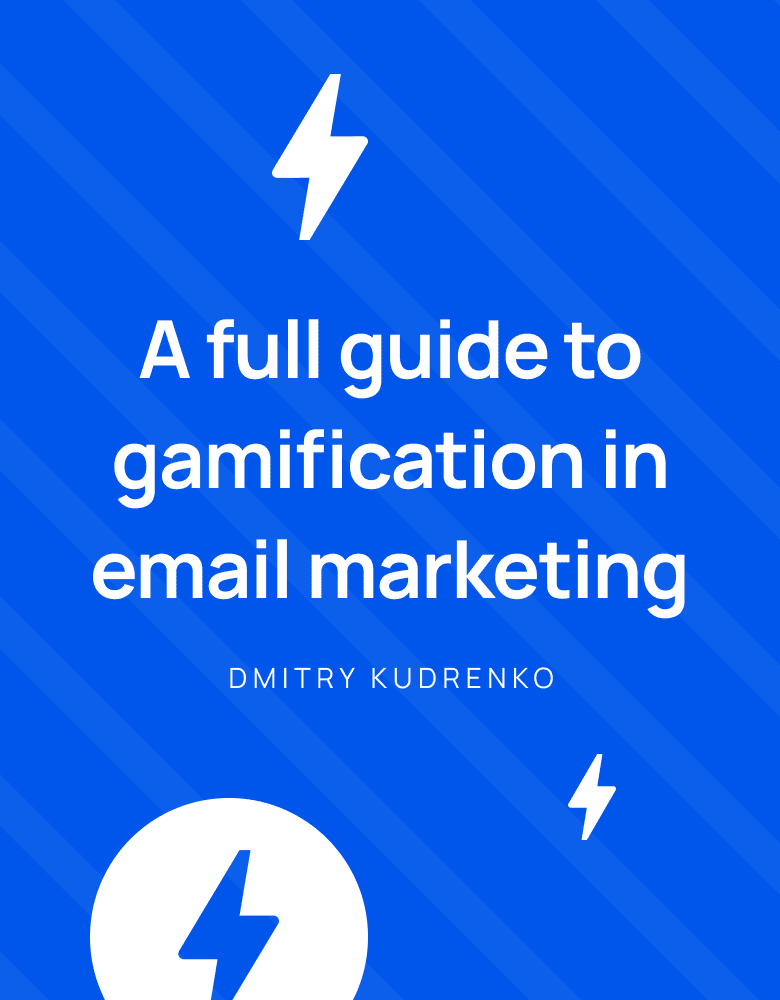

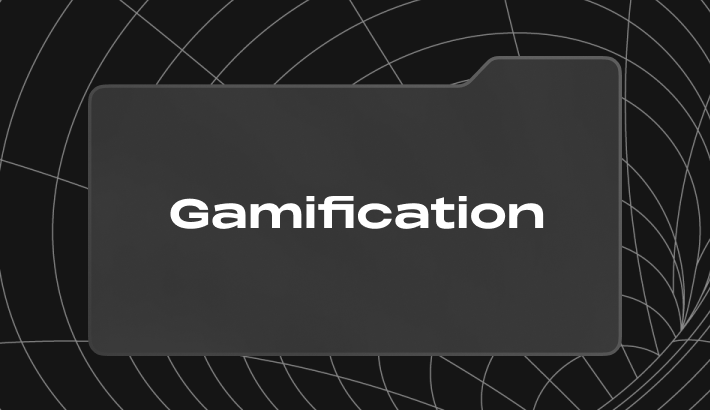



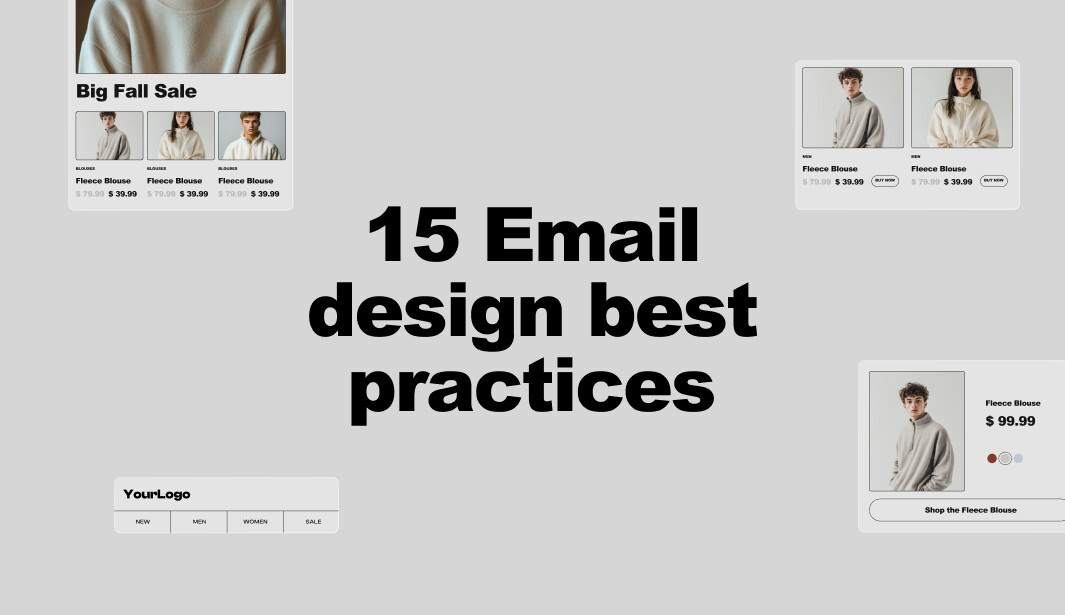

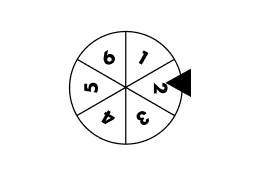
0 коментарів